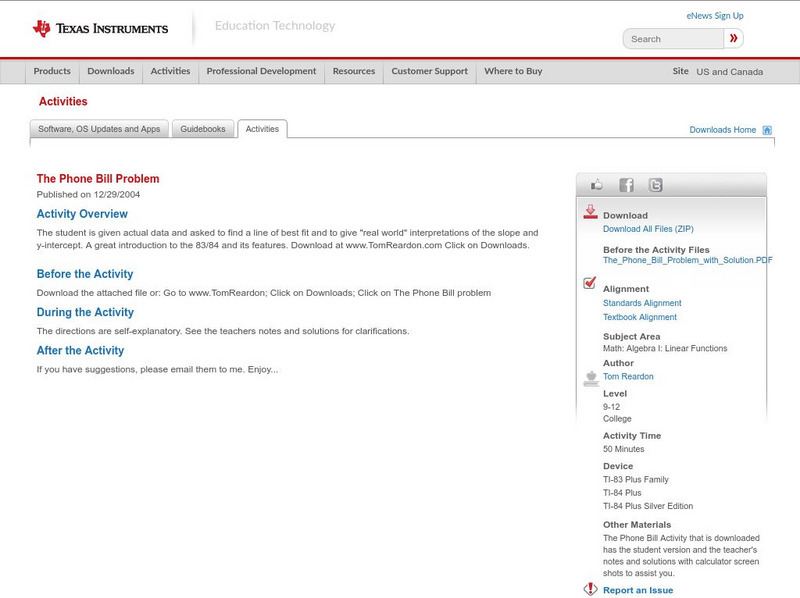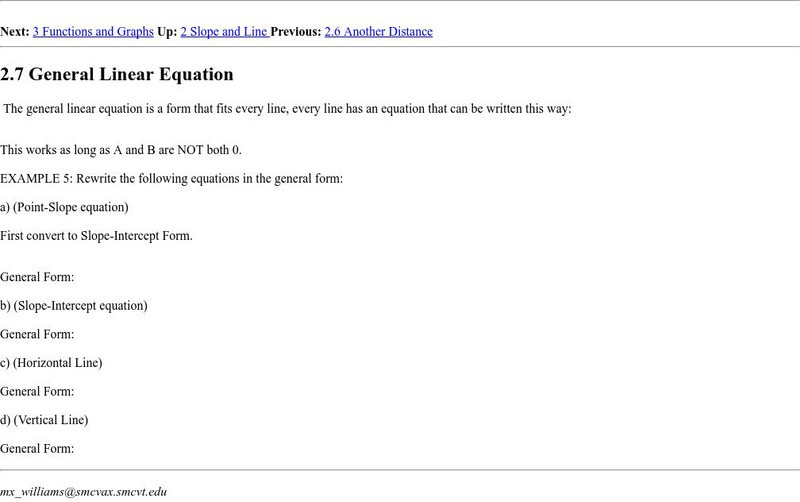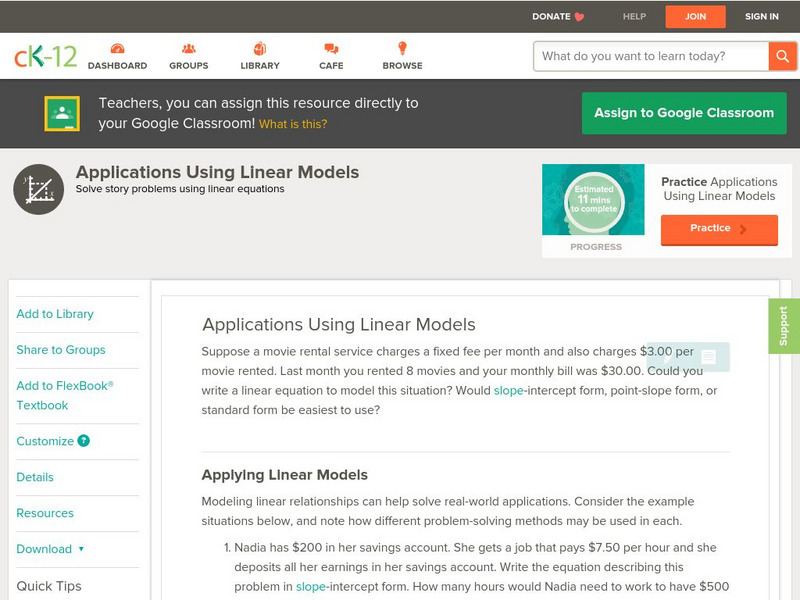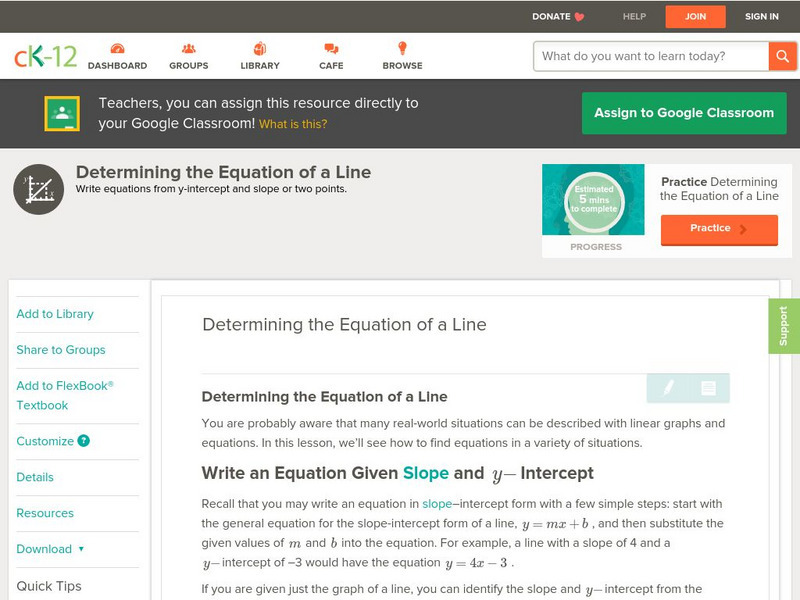Curated OER
To Be Linear or Not to be Linear, That is the Question
Students use their knowledge and understanding of equations of lines to explore independent and dependent variables. They determine how to isolate a variable and how to predict data points not represented in data.
Curated OER
Exploring Linear Equations
Third graders use graphing calculators to graph equations. They make visual models of algebraic expressions and they can readily see that an equation represents something.
Curated OER
Linear Equations
In this Algebra I activity, 9th graders match vocabulary words relating to linear equations to their definition in a drag and drop game format. The one page interactive activity contains seven matching questions and is self...
Curated OER
Linear Equations
Ninth graders solve linear equations. In this Algebra I lesson plan, 9th graders investigate the properties of equations (Reflexive, Symmetric, Transitive, Substitution, and Transformation Properties) and use these properties to...
Curated OER
Mine Lesson #1: Slope slider
Eighth graders investigate linear equations. In this Algebra I lesson plan, 8th graders explore the effects that manipulating a linear equation has on the graph of the function through the use of a java...
Curated OER
Algebra I: Scatter Plots
In this scatter plot worksheet, students write an equation for a line that would fit the given scatter plot. They create scatter plots from given information. This two-page worksheet contains eight problems.
Curated OER
Setting up Systems
In this systems of equations worksheet, students solve 2 different problems that include setting up various systems. They compute a given system using matrix operations. Then, students verify that the solution is correct by drawing a set...
Curated OER
Modeling Two Step Equations
Students study linear equations. Using algebra tiles, they model solving two-step linear equations. They discuss inverse operations, demonstrate solutions and justify answers. Given worksheets, students solve real world problems.
Curated OER
Microteaching
Tenth graders use the mathematical program, MATHEMATICA and graph linear and quadratic equations. They sketch the graph of an equation manually. Students compare their sketch with the computer generated model of the graph.
TeachEngineering
Teach Engineering: Linear Equations Game
Students groups act as aerospace engineering teams competing to create linear equations to guide space shuttles safely through obstacles generated by a modeling game in level-based rounds. Each round provides a different configuration of...
Texas Instruments
Texas Instruments: The Phone Bill Problem
The student is given actual data and asked to find a line of best fit and to give "real world" interpretations of the slope and y-intercept. A great introduction to the 83/84 and its features.
Texas Instruments
Texas Instruments: Getting Started With the Ti Navigator: What's My Line
This lesson introduces students to Activity Center and is intended to help students understand the meaning of slope and y-intercept. They will explore the relationships between symbolic expressions and graphs of lines by using Activity...
Texas Instruments
Texas Instruments: Step by Step Activity Data Collection & Analysis
In this activity, students create a situation that produces linear behavior by stepping heel to toe and taking distance readings as each step is taken. Students then apply the properties of a linear function to develop a model for motion.
Northeast Parallel Architectures Center, Syracuse University
Npac Reu Program: General Linear Equation
This site by the Northeast Parallel Architecture Center, Syracuse University, shows the different forms of linear equations for a line.
Math Is Fun
Math Is Fun: Linear Equation Test
This interactive site checks students' understanding of slope and intercept. Seven question require students to determine slope and intercept of a line from the graph. The site is a test that can be scored on-line.
CK-12 Foundation
Ck 12: Algebra: Applications Using Linear Models
[Free Registration/Login may be required to access all resource tools.] In this lesson students write and solve linear equations to model real-world scenarios. Students watch a video tutorial, explore guided notes and attempt practice...
CK-12 Foundation
Ck 12: Algebra: Forms of Linear Equations
[Free Registration/Login may be required to access all resource tools.] Write linear equations in standard form and find the slope and y-intercept of such lines.
CK-12 Foundation
Ck 12: Algebra: Applications Using Linear Models
[Free Registration/Login may be required to access all resource tools.] In this lesson students learn how to use various forms of linear equations to solve problems. Students watch a video tutorial, explore guided notes and attempt...
CK-12 Foundation
Ck 12: Algebra: Determining the Equation of a Line
[Free Registration/Login may be required to access all resource tools.] In this lesson students write the equations of lines in point-slope form and in slope-intercept form and graph linear equations. Students examine guided notes,...
CK-12 Foundation
Ck 12: Algebra: Equations of Perpendicular Lines
[Free Registration/Login may be required to access all resource tools.] Learn how to recognize and write equations of perpendicular lines.
Paul Dawkins
Paul's Online Notes: Differential Equations: First Order Differential Equations
The tutorial explores first order differential equations. Topics examined are linear equations, separable equations, Bernoulli differential equations, equilibrium solutions, Euler?s method, and intervals of validity. Class notes,...
CK-12 Foundation
Ck 12: Algebra: Write a Function in Slope Intercept Form
[Free Registration/Login may be required to access all resource tools.] Learn to write a function in slope-intercept form
Oswego City School District
Regents Exam Prep Center: Linear Equations
This site gives information on solving linear equations and offers practice problems, a thorough lesson, and teacher resources.
Khan Academy
Khan Academy: Algebra I: Writing Linear Functions Word Problems
Find a linear function that represents a real-world relationship that is given verbally. Students receive immediate feedback and have the opportunity to try questions repeatedly, watch a video, or receive hints.

























